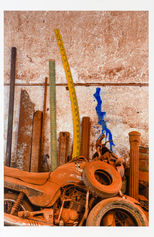

From Debris We Rise
M. Pravat
Curatorial Advisor - Anushka Rajendran
January 11, 2024 - January 17, 2024
From Debris, We Rise is an amalgamation of recent works from M Pravat’s studio, which are all mimetic transmutations of the context it is nestled within, the village of Rajpur in Chattarpur, Delhi. Delhi, once a city, then a state, eventually began to spill into its neighbouring states of Haryana, Uttar Pradesh and Rajasthan, encompassing the Delhi National Capital Region (NCR). This horizontal expansion also remarkably brings about rapid contractions of neighbourhoods old and new, as they begin to choke with newer, unplanned and occasionally semi-legal constructions and additions to keep up with the city’s accelerationist model of
development. This is especially the case with Chattarpur, a locality that is spread along the Delhi-Gurgaon highway, strategically located between both cities as an overlooked conduit of people, traffic, businesses of all scales, factories, cottage industries and affordable accommodations to suit the needs of its older inhabitants that desperately seek profit from the multitudinal influx of people into the city each day looking to make a home there. Perhaps as an unconscious, residual impulse from Pravat’s early encounters with the
experimental theatre scene in Kolkata where he grew up, and the villages of West Bengal, essaying plural roles as scenographer, prop designer, and voice actor, his practice consistently attempts to critically reinterpret and perform in the studio, processes that he observes in the world around him. The mise en scène is set by discarded debris from demolitions and constructions in Chattarpur that he collects and brings to his studio, which consequently comes to be doused in a veneer of brick dust. The sensorial environment of the construction site is mirrored by the studio as well with its temporary asbestos roof, pliability to the extreme climatic conditions of Delhi, and hazardous material residue, while also echoing
its acoustics. Within its confines, he follows methods of making that are similar to those that are familiar to the building industry, collaborating with stone workers and brick masons to render works that speak to the urbanisation of the city. His process alternates between the subtractive Brechtian aesthetics that perhaps come to him from his engagement with theatre and an alchemical metamorphosing of drab debris into softer, delicate forms that reclaim the ugliness of redevelopment in the locality, which once used to be forested land. The works are material testimonies of infinite expansion, and abstract actors performing the
logic of materialism.
At Bungalow 8, in the underbelly of the Wankhede Stadium where the structural formations that support this iconic theatre of athletics and nationalist machismo reveal themselves in the ceiling, the exhibition dialogues with the space, formulating a self-referential interrogation of the ‘foundation’ of built structures. Insignia imagined from broken jalis and repurposed construction material forge columns—a built form that signifies power and grandeur—to be mirrored into infinity, rising endlessly. Another series of works crafted from brick dust and slate indicates waning space in the city, and the obscuring of the moon in the sky amidst
high rises in inverted perspective, as if we are looking down upon the Earth from the sky. An outline map of Rajpur is cut across by a red hot laser light, responding to rapidly rising temperatures of the earth and the ecological crisis prompted by unsustainable approaches that favour the rise of capital. These works are anchored to the studio of the artist where these considerations transpire in his treatment of some of the substances that flag anthropogenic interference upon the surface of the planet. The texture of the studio/site is revealed, and the romance of development is stripped away with acid and embellished with debris and forms that demystify the gleam of a newly built structure. What rises from debris shall also return to debris, hopefully with some permanence as these practices are increasingly acknowledged as unsustainable in the public imagination.
— Anushka Rajendran, 2024
Installation Views








Selected Artworks






